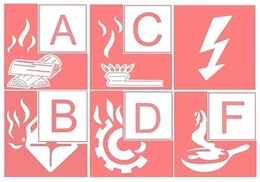Blogs
PCSBBA-0001
Understanding Fire Classes:
A Comprehensive Guide to Fire Safety
Fires are one of the most common and dangerous emergencies, capable of causing significant harm to people, property, and the environment. Understanding the different types of fires, categorized by their fuel sources, is key to effective fire prevention and response. In this guide, we’ll break down the different fire classes, their unique characteristics, and why this knowledge is essential for fire safety.
What Are Fire Classes?
Fire classes are a classification system used to categorize fires based on the type of fuel burning. This system helps determine the most effective method for extinguishing a fire and ensures the safety of responders. The five main fire classes recognized globally are:

Class A Fires
- Fires fuelled by ordinary combustibles such as wood, paper, cloth, rubber, and certain plastics.
- These fires produce ash as they burn and are often the most common type of fire in residential and office settings.
- Use water, foam, or dry chemical extinguishers to cool and smother the flames.
Class B Fires
- Fires involving flammable liquids or gases such as gasoline, oil, kerosene, alcohol, propane, or butane.
- These fires spread rapidly and pose a high risk of explosions.
- Foam, carbon dioxide (CO₂), or dry chemical extinguishers are effective in smothering and cooling these fires.
Class C Fires
- Fires involving energized electrical equipment such as wiring, circuit breakers, appliances, and machinery.
- These fires can become a serious hazard if water is used, as it conducts electricity.
- Non-conductive extinguishers, such as CO₂ or dry chemical, are the safest options.
Class D Fires
- Fires fuelled by combustible metals like magnesium, titanium, sodium, or aluminium.
- These fires burn at extremely high temperatures and can react violently with water or other extinguishing agents.
- Use specialized dry powder extinguishers designed for metal fires.
Class F Fires
- Fires caused by cooking oils, greases, and fats, commonly occurring in kitchens.
- These fires can reignite if not properly extinguished.
- Wet chemical extinguishers cool the flames and form a saponified barrier to prevent re-ignition.
Electrically Started Fires
- Fires initiated by electrical faults, such as short circuits, overloaded wiring, or faulty appliances.
- These fires often start small but can quickly ignite surrounding materials, leading to Class A, B, or C fires depending on the fuel involved.
- First, de-energize the electrical source if safe to do so. Use non-conductive extinguishers such as CO₂ or dry chemical to suppress the flames.
Why Knowing Fire Classes Matters?
- Targeted Extinguishing: Using the wrong extinguishing agent can worsen a fire or create additional hazards. For instance, water can spread Class B fires and cause electric shock in Class C fires.
- Enhanced Safety: Recognizing fire classes allows individuals and emergency responders to approach fires more safely and effectively.
- Compliance and Preparedness: Many workplaces and facilities are required by law to have fire extinguishers appropriate for their specific fire risks. Knowing fire classes ensures compliance with safety regulations.
- Fire Prevention: Understanding the fuel sources of various fires can help identify and mitigate potential hazards in homes, workplaces, and public spaces.
Fire Prevention Tips for Each Class
- Class A: Keep flammable materials away from heat sources. Dispose of waste like paper and fabric regularly to reduce fire risk.
- Class B: Store flammable liquids and gases in well-ventilated areas away from open flames or sparks. Use spill-proof containers.
- Class C: Ensure electrical systems are well-maintained. Avoid overloading circuits and unplug appliances when not in use.
- Class D: Handle combustible metals with care in controlled environments. Train personnel in appropriate safety procedures.
- Class F: Install grease traps and maintain them regularly. Avoid leaving cooking equipment unattended.
- Electrically Started Fires: Regularly inspect and maintain electrical systems. Use surge protectors and avoid overloading sockets. Have a qualified electrician address any wiring issues promptly.
Understanding fire classes is the first step in preventing and managing fire-related emergencies. Whether you’re at home, at work, or in a public space, this knowledge empowers you to act quickly and effectively when it matters most. Equip your environment with the appropriate fire extinguishers, educate those around you, and prioritize fire safety to protect lives and property.
